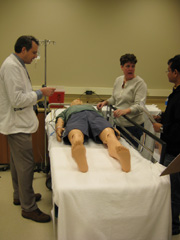Next Generation of Health Care Workers Train Through Medical Simulation
Simulation reinforces lessons in safety, communication and teamwork for MU and UMKC students
May 19, 2009
Story Contact: Emily Smith, (573) 882-3346, SmithEA@missouri.edu
COLUMBIA, Mo. - Soldiers and pilots use simulation training to learn accuracy, safety and confidence. Now, University of Missouri medical, nursing, health professions and University of Missouri- Kansas City pharmacy instructors are using medical simulation to train students to recognize safety risks, communicate effectively and work with other health professionals.
"Effective training is needed to help students recognize safety issues, such as assuring that medication and infection risks are minimized, before they enter professional health care settings," said Carla Dyer, assistant professor in the MU School of Medicine. "We are addressing this need by emphasizing lessons in patient safety and quality of care through clinical simulation training for students."
MU medical and nursing students, respiratory therapy students, health management and informatics students, and UMKC pharmacy students participate in interdisciplinary simulations that mimic busy emergency rooms. A typical simulation is hectic - crying babies, people shouting in pain and asking for help. Students are orientated to the scenario and then must work together to efficiently treat several patients. Students are instructed to identify and alleviate various safety risks while communicating with the ‘patients' and each other.
"Medical and nursing students don't have many opportunities to train together and interact with pharmacists and hospital managers until they are in a professional setting - the students' lack of experience and confidence can affect patient care," said Gretchen Gregory, clinical instructor in the MU Sinclair School of Nursing. "Group simulation requires students to interact with other health professionals and care for patients as a team."
At many universities, medical, nursing, pharmacy and health professions students are trained separately and simulation training is used to improve teamwork and communication. MU and UMKC instructors recognized the need to integrate students and also incorporate patient safety and care into simulation training at the MU Russell D. and Mary B. Shelden Clinical Simulation Center.
The simulation training at MU reinforces the 2009 national patient safety goals, which include:
- Identify patients correctly by verifying names and birth dates;
- Improve staff communication by standardizing reports and documenting treatments;
- Use medicine safely by checking correct dosage and identifying patient allergies;
- Reduce falls by identifying at-risk patients and reporting all falls.
The first inter-professional simulations took place in February. MU and UMKC instructors are evaluating students' feedback to identify best practices and areas for improvement. Continuing evaluation will ensure the most effective techniques are used to train future students, Gregory said.
"The opening of the UMKC satellite school of pharmacy in Columbia has increased the opportunity for students from various healthcare backgrounds to interact and understand each other's roles in patient care," said Deepti Vyas, assistant professor in the UMKC School of Pharmacy.
In April, MU instructors presented information about interdisciplinary medical simulations at the Institute for Healthcare Improvement Health Professions Education Collaborative Meeting at the University of Manitoba in Winnipeg, Manitoba. For more information, visit http://som.missouri.edu/SimCenter/
-30-





 Photos (2):
Photos (2): Audio:
Audio: